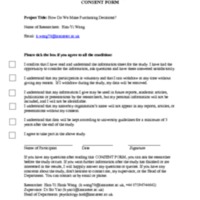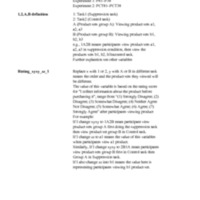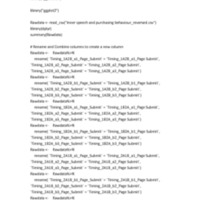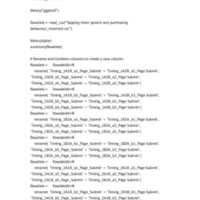Inner Speech and Its Role in Purchasing Decision-Making Process: Analysis of Within-Subjects Experiment and Questionnaires
Dublin Core
Title
Inner Speech and Its Role in Purchasing Decision-Making Process: Analysis of Within-Subjects Experiment and Questionnaires
Creator
Han-Yi Wang
Date
03/Sep/2023
Description
Inner speech is a cognitive function related to language processes. Based on its functions reflecting information processing and memorising, it may link to the purchasing process, which includes searching and evaluating product information. Inner speech may also help people think and imagine using the product in the future during their purchasing process.
This study discussed and investigated the role of inner speech in the purchasing process and how it might affect the decision-making time. This study also mentioned how inner speech may be identified and suppressed. Participants’ data was collected through experiments and several questionnaires. The findings indicated that inner speech might help people in Information Search and Alternative evaluation and affect decision time. The findings also suggested what people may consider and how they use inner speech.
By uncovering the potential relationship between the purchasing process and inner speech, this research provided valuable information for marketing and psychology research fields. It gave companies some suggestions for practical use, reflecting how people may use inner speech during the purchasing process.
This study discussed and investigated the role of inner speech in the purchasing process and how it might affect the decision-making time. This study also mentioned how inner speech may be identified and suppressed. Participants’ data was collected through experiments and several questionnaires. The findings indicated that inner speech might help people in Information Search and Alternative evaluation and affect decision time. The findings also suggested what people may consider and how they use inner speech.
By uncovering the potential relationship between the purchasing process and inner speech, this research provided valuable information for marketing and psychology research fields. It gave companies some suggestions for practical use, reflecting how people may use inner speech during the purchasing process.
Subject
Inner speech, memory, decision-making, purchasing behaviour.
Source
This study was approved by ethics committees at Lancaster University. There were no ethical issues for researchers managing the personal information. The participants’ information remained anonymous and were assigned subject ID (P01, P02, P03…, P30 in Experiment 1 and PCT01, PCT02, PCT03…, PCT30 in Experiment 2). All data were stored anonymously with no identifiable information.
Participants were given the Participant Information Sheet (PIS) before participating in the experiments. On the day of testing, they asked any questions they might have, then consented to attend the experiment in person or via online platforms like Microsoft Teams, Zoom, or Google Meet to ensure that the suppression was active when needed. The experiment took approximately 30 minutes, including answering all questionnaires. The experiment was held in the participant’s home or a place where no one spoke so that the participant would not be disturbed by any chance.
Experiment 1
Participants
G*power suggested 52 participants within groups using t-tests and multiple mixed linear regression models, with a .4 effect size and .05 (5%) a-error probability in 80% power (1-b error of probability) (Brysbaert, 2019). Thirty participants were recruited in this experiment with no record or history of neurophysiological disorders, such as dyslexia or aphasia, to ensure that no conditions influence the result and affect the participant to complete the tasks in the experiment. The recruitment process included in-person invitations around campus and social media messages to reach diverse participants.
Although only 30 participants were recruited in this experiment, the results of the t-tests suggest that the effect size (see Experiment 1 result section) may be enough for testing the hypothesis.
Design
This study was an experimental within-subjects design. Participants simulated purchase experience in the suppression task and the control task without interference assigned to them. The independent variables were self-rating agreements on information search and alternative evaluation and participants’ average decision time in the suppression and control tasks. The dependent variables were inner speech frequency in five dimensions measured by the Inner Speech Frequency Questionnaire (VISQ).
Quantitative data were analysed using R to conduct t-tests, GLMM and CLMM. Secondly, qualitative data were collected through questionnaires and categorised into different variables to identify why participants made the decisions and their inner speech content during the purchasing process.
Overall, the experiment aims to investigate how people use inner speech during purchasing and whether Articulate Suppression task and task without interference influenced decision time and agreement score on information search and alternative evaluation.
Materials
Stimuli
Participants viewed six product sets (stimuli), which information was copied from the official website. To prevent participants from focusing on the effect of the products’ brands and prices (Albari & Safitri, 2020), the products in each set were the same brand with similar or the same price, unisex, and recognisable, although these products might not exist or remain the latest information on the market.
Two-item Statement Questions (see Appendix B)
Participants rated the two statements on a seven-point Likert score from strongly disagree to strongly agree (Maity & Dass, 2014) to identify the Information Search and Alternative evaluation agreement level between tasks. Then, participants were asked: “Which product did you choose? Why?” after each purchasing decision.
Variety of Inner Speech Frequency Questionnaire (VISQ, see Appendix C)
The Inner Speech Frequency Questionnaire (Alderson-Day et al., 2018) included twenty questions asking participants to generally rate their inner speech frequency after the mock e-commerce purchasing tasks with a 7-point Likert scale ranging from "Never" to "All the time". Questions 7 and 15 were reversely coded; the value should be reversely calculated when doing analysis.
Experiment 1 Qualitative Questions (ExpQ1, see Appendix D)
After participants finished all the tasks (six decisions), they were asked to answer three questions at the end of the experiment. These questions gathered qualitative data about the participants’ experiences during the mock e-commerce purchasing tasks and what they had in mind.
Procedure
Figure 2 illustrates the diagram of Experiment 1. Participants were invited and consented to join the research to do Suppression and Control (without interference) tasks.
Each task contained three product sets; participants were asked to imagine and choose a product for themselves or a friend according to the provided information on the mock e-commerce channel (Maity & Dass, 2014). The screen of the researcher or participants presented the information, including the price and details of the product set. Since these two tasks are counterbalanced and randomly ordered, participants repeated the decision-making process three times in the control task and the other three in the suppression task. After each decision, participants answered the two-statement questionnaire and explained which products they chose and why they chose them. According to different tasks, they started with the control task by themselves. However, they were asked to practise counting out loud from 1 to 4 following 160 bpm metronome sounds until the researcher ensured they remained suppressed before starting the suppression task.
Then, they answered VISQ, which measured their inner speech frequency and qualitative questionnaires (ExpQ1) to understand how they used inner speech when viewing the products in the last part of the study.
Analysis
R was used to analyse the quantitative data to identify the task differences via t-tests and the relationship between variables in two tasks via Generalised Linear Mixed Effect Models (GLMM) and Cumulative Link Mixed Model (CLMM). When conducting the GLMM with family gamma, the quantitative data will follow the standard procedure of data trimming and keep the trimmed data within 5% or 2.5 standard deviations (Berger & Kiefer, 2021).
The qualitative coding scheme (See Appendix F) was created to identify what participants considered and what they said to themselves using inner speech during the experiment. The coding process involved re-reading the data to identify and assign relevant contexts to the appropriate categories. For example, if participants mention that they have used the product before, the value of the variable “Memory” increases by one unit. These variables were then calculated to identify what factors influenced participants’ purchasing decision-making more. Following the same coding scheme, what kind of inner speech was used when viewing the products could also be found. For example, people may ask themselves questions or repeat the product in mind.
In summary, Quantitative and qualitative data were analysed to report the results for different purposes and test the hypothesis in this research.
Figure 2
The Diagram of Experiment 1 Procedure
Note: Participants were required to do suppression and control tasks, the order was randomised and counterbalanced. The products presented during the tasks were also randomised.
Experiment Optimising
The task without interference in Experiment 1 may not be a reasonable control task since it might include the secretary task effect, as participants were asked to do both tasks and be influenced after they did the suppression task when they were doing the control task.
As a secretary task, the finger-tapping task, which has been used in inner speech experiments, could be the better control task in Experiment 2 (Emerson & Miyake, 2003; Wallace et al., 2009). Although Finger-tapping might influence working memory’s function and influence people to memorise (Armson et al., 2019; Kane & Engle, 2000; Moscovitch, 1994; Rose et al., 2009), Rogalsky et al. (2008) also mentioned that the performance of people’s understanding of complex sentences might decrease but not as much as suppression occur.
Therefore, doing the second experiment was motivated to replicate the results with a better control condition involving Finger-tapping.
Experiment 2
Participants
Based on the findings of Experiment 1, another 30 participants were recruited with the duplicate requirements as the first experiment. The recruitment requirement and process were the same as in the previous experiment.
Design
The independent variables were similar to Experiment 1, while the only difference was that the control task here had been changed into the Finger-tapping task. The goal of the whole design is to replicate the results of Experiment 1 to investigate the role of inner speech in the purchasing process.
Materials
Experiment 2 applied the same materials used in Experiment 1. The only difference was the qualitative questions after tasks. In Experiment 1, participants answered “Experiment 1 Qualitative Questions” at the end of the experiment. However, to better understand the difference between tasks, they were asked to answer a similar questionnaire (see below) after each task to discover the inner speech used in the two tasks.
Experiment 2 Qualitative Questions (ExpQ2, see Appendix E)
Participants were asked to answer three questions about their experiences during the mock e-commerce purchasing tasks and what they had in mind for the Suppression and Finger-tapping tasks separately.
Procedure
The procedure was the same as the first experiment, except for adjusting the control task and the order of the qualitative questionnaire (ExpQ2). Figure 3 illustrates that participants were invited to the experiment using the same stimuli, similar questionnaires, and the same method of presenting stimuli (participants joined in person or via online platforms) with Suppression and Finger-tapping tasks. Participants were asked to practice counting 1,2,3,4 out loud or tapping their index, middle, ring, and little fingers in order (see which task came first) following metronome beats at 160 bpm before the researchers decided to move on. They were asked to view the product set by imagining choosing one for a friend or themselves three times in each task. Participants answered two statements and answered what product was chosen and why after each decision they made. Then, they were asked to answer three Qualitative questions (Appendix E) after each task. They repeated another task in the same process afterwards with a 2-minute break between tasks. After they finished the Finger-tapping and Suppression tasks, they answered VISQ questions at the end of the experiment.
Analysis
R was also used to analyse the quantitative data for the same purposes and followed the same data-trimming procedure if needed. The same coding scheme was followed to generate the result that could replicate and optimise the clarity of the Experiment 1 results. Overall, the second experiment is to generate the same or more evident results as Experiment 1 and to find more valuable information for the different inner speech used between tasks.
In conclusion, these two experiments and the analysis might give this research a deeper understanding of inner speech and its role and provide more precise information on how inner speech may related to the purchasing process.
Figure 3
The Diagram of Experiment 2 Procedure
Note: Participants were required to do suppression and control tasks, the order was randomised and counterbalanced. The products presented during the tasks were also randomised.
Participants were given the Participant Information Sheet (PIS) before participating in the experiments. On the day of testing, they asked any questions they might have, then consented to attend the experiment in person or via online platforms like Microsoft Teams, Zoom, or Google Meet to ensure that the suppression was active when needed. The experiment took approximately 30 minutes, including answering all questionnaires. The experiment was held in the participant’s home or a place where no one spoke so that the participant would not be disturbed by any chance.
Experiment 1
Participants
G*power suggested 52 participants within groups using t-tests and multiple mixed linear regression models, with a .4 effect size and .05 (5%) a-error probability in 80% power (1-b error of probability) (Brysbaert, 2019). Thirty participants were recruited in this experiment with no record or history of neurophysiological disorders, such as dyslexia or aphasia, to ensure that no conditions influence the result and affect the participant to complete the tasks in the experiment. The recruitment process included in-person invitations around campus and social media messages to reach diverse participants.
Although only 30 participants were recruited in this experiment, the results of the t-tests suggest that the effect size (see Experiment 1 result section) may be enough for testing the hypothesis.
Design
This study was an experimental within-subjects design. Participants simulated purchase experience in the suppression task and the control task without interference assigned to them. The independent variables were self-rating agreements on information search and alternative evaluation and participants’ average decision time in the suppression and control tasks. The dependent variables were inner speech frequency in five dimensions measured by the Inner Speech Frequency Questionnaire (VISQ).
Quantitative data were analysed using R to conduct t-tests, GLMM and CLMM. Secondly, qualitative data were collected through questionnaires and categorised into different variables to identify why participants made the decisions and their inner speech content during the purchasing process.
Overall, the experiment aims to investigate how people use inner speech during purchasing and whether Articulate Suppression task and task without interference influenced decision time and agreement score on information search and alternative evaluation.
Materials
Stimuli
Participants viewed six product sets (stimuli), which information was copied from the official website. To prevent participants from focusing on the effect of the products’ brands and prices (Albari & Safitri, 2020), the products in each set were the same brand with similar or the same price, unisex, and recognisable, although these products might not exist or remain the latest information on the market.
Two-item Statement Questions (see Appendix B)
Participants rated the two statements on a seven-point Likert score from strongly disagree to strongly agree (Maity & Dass, 2014) to identify the Information Search and Alternative evaluation agreement level between tasks. Then, participants were asked: “Which product did you choose? Why?” after each purchasing decision.
Variety of Inner Speech Frequency Questionnaire (VISQ, see Appendix C)
The Inner Speech Frequency Questionnaire (Alderson-Day et al., 2018) included twenty questions asking participants to generally rate their inner speech frequency after the mock e-commerce purchasing tasks with a 7-point Likert scale ranging from "Never" to "All the time". Questions 7 and 15 were reversely coded; the value should be reversely calculated when doing analysis.
Experiment 1 Qualitative Questions (ExpQ1, see Appendix D)
After participants finished all the tasks (six decisions), they were asked to answer three questions at the end of the experiment. These questions gathered qualitative data about the participants’ experiences during the mock e-commerce purchasing tasks and what they had in mind.
Procedure
Figure 2 illustrates the diagram of Experiment 1. Participants were invited and consented to join the research to do Suppression and Control (without interference) tasks.
Each task contained three product sets; participants were asked to imagine and choose a product for themselves or a friend according to the provided information on the mock e-commerce channel (Maity & Dass, 2014). The screen of the researcher or participants presented the information, including the price and details of the product set. Since these two tasks are counterbalanced and randomly ordered, participants repeated the decision-making process three times in the control task and the other three in the suppression task. After each decision, participants answered the two-statement questionnaire and explained which products they chose and why they chose them. According to different tasks, they started with the control task by themselves. However, they were asked to practise counting out loud from 1 to 4 following 160 bpm metronome sounds until the researcher ensured they remained suppressed before starting the suppression task.
Then, they answered VISQ, which measured their inner speech frequency and qualitative questionnaires (ExpQ1) to understand how they used inner speech when viewing the products in the last part of the study.
Analysis
R was used to analyse the quantitative data to identify the task differences via t-tests and the relationship between variables in two tasks via Generalised Linear Mixed Effect Models (GLMM) and Cumulative Link Mixed Model (CLMM). When conducting the GLMM with family gamma, the quantitative data will follow the standard procedure of data trimming and keep the trimmed data within 5% or 2.5 standard deviations (Berger & Kiefer, 2021).
The qualitative coding scheme (See Appendix F) was created to identify what participants considered and what they said to themselves using inner speech during the experiment. The coding process involved re-reading the data to identify and assign relevant contexts to the appropriate categories. For example, if participants mention that they have used the product before, the value of the variable “Memory” increases by one unit. These variables were then calculated to identify what factors influenced participants’ purchasing decision-making more. Following the same coding scheme, what kind of inner speech was used when viewing the products could also be found. For example, people may ask themselves questions or repeat the product in mind.
In summary, Quantitative and qualitative data were analysed to report the results for different purposes and test the hypothesis in this research.
Figure 2
The Diagram of Experiment 1 Procedure
Note: Participants were required to do suppression and control tasks, the order was randomised and counterbalanced. The products presented during the tasks were also randomised.
Experiment Optimising
The task without interference in Experiment 1 may not be a reasonable control task since it might include the secretary task effect, as participants were asked to do both tasks and be influenced after they did the suppression task when they were doing the control task.
As a secretary task, the finger-tapping task, which has been used in inner speech experiments, could be the better control task in Experiment 2 (Emerson & Miyake, 2003; Wallace et al., 2009). Although Finger-tapping might influence working memory’s function and influence people to memorise (Armson et al., 2019; Kane & Engle, 2000; Moscovitch, 1994; Rose et al., 2009), Rogalsky et al. (2008) also mentioned that the performance of people’s understanding of complex sentences might decrease but not as much as suppression occur.
Therefore, doing the second experiment was motivated to replicate the results with a better control condition involving Finger-tapping.
Experiment 2
Participants
Based on the findings of Experiment 1, another 30 participants were recruited with the duplicate requirements as the first experiment. The recruitment requirement and process were the same as in the previous experiment.
Design
The independent variables were similar to Experiment 1, while the only difference was that the control task here had been changed into the Finger-tapping task. The goal of the whole design is to replicate the results of Experiment 1 to investigate the role of inner speech in the purchasing process.
Materials
Experiment 2 applied the same materials used in Experiment 1. The only difference was the qualitative questions after tasks. In Experiment 1, participants answered “Experiment 1 Qualitative Questions” at the end of the experiment. However, to better understand the difference between tasks, they were asked to answer a similar questionnaire (see below) after each task to discover the inner speech used in the two tasks.
Experiment 2 Qualitative Questions (ExpQ2, see Appendix E)
Participants were asked to answer three questions about their experiences during the mock e-commerce purchasing tasks and what they had in mind for the Suppression and Finger-tapping tasks separately.
Procedure
The procedure was the same as the first experiment, except for adjusting the control task and the order of the qualitative questionnaire (ExpQ2). Figure 3 illustrates that participants were invited to the experiment using the same stimuli, similar questionnaires, and the same method of presenting stimuli (participants joined in person or via online platforms) with Suppression and Finger-tapping tasks. Participants were asked to practice counting 1,2,3,4 out loud or tapping their index, middle, ring, and little fingers in order (see which task came first) following metronome beats at 160 bpm before the researchers decided to move on. They were asked to view the product set by imagining choosing one for a friend or themselves three times in each task. Participants answered two statements and answered what product was chosen and why after each decision they made. Then, they were asked to answer three Qualitative questions (Appendix E) after each task. They repeated another task in the same process afterwards with a 2-minute break between tasks. After they finished the Finger-tapping and Suppression tasks, they answered VISQ questions at the end of the experiment.
Analysis
R was also used to analyse the quantitative data for the same purposes and followed the same data-trimming procedure if needed. The same coding scheme was followed to generate the result that could replicate and optimise the clarity of the Experiment 1 results. Overall, the second experiment is to generate the same or more evident results as Experiment 1 and to find more valuable information for the different inner speech used between tasks.
In conclusion, these two experiments and the analysis might give this research a deeper understanding of inner speech and its role and provide more precise information on how inner speech may related to the purchasing process.
Figure 3
The Diagram of Experiment 2 Procedure
Note: Participants were required to do suppression and control tasks, the order was randomised and counterbalanced. The products presented during the tasks were also randomised.
Publisher
Lancaster University
Format
The data format is csv.
Identifier
Wang03092023
Contributor
Han-Yi Wang
Rights
Open (unless stated otherwise)
Relation
None (unless stated otherwise)
Language
English
Type
Data or text
Coverage
LA1 4YF
LUSTRE
Supervisor
Dr. Bo, Yao
Project Level
MSc
Topic
Cognitive
Cognitive - developmental
Marketing
Cognitive - developmental
Marketing
Sample Size
60 participants, 30 in the Experiment 1 and 30 in the Experiment 2.
Statistical Analysis Type
Quantitative- t-tests, GLMM, CLMM
Qualitative-Thematic
Qualitative-Thematic
Files
Collection
Citation
Han-Yi Wang, “Inner Speech and Its Role in Purchasing Decision-Making Process: Analysis of Within-Subjects Experiment and Questionnaires,” LUSTRE, accessed April 28, 2024, https://www.johnntowse.com/LUSTRE/items/show/179.




